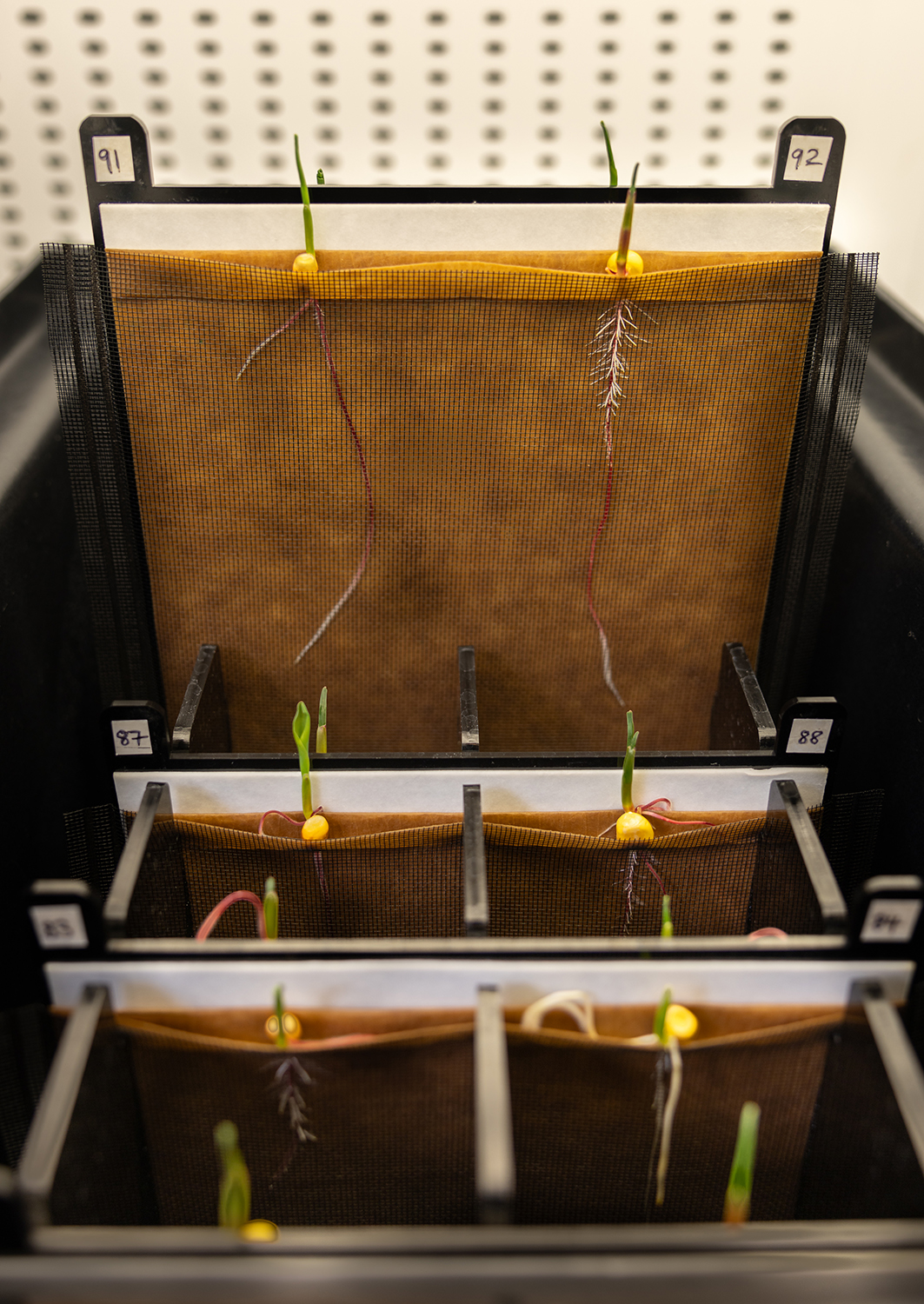A corn plant knows how to find water in soil with the very tips of its roots, but some varieties, including many used for breeding high-yielding corn in the U.S., appear to have lost a portion of that ability, according to a Stanford-led study. With climate change increasing droughts, the findings hold potential for developing more resilient varieties of corn.
The study, published in the journal Science, uncovers genetic mechanisms behind root "hydropatterning," or how plant roots branch toward water and avoid dry spaces in soil. In particular, the researchers discovered that ethylene, a plant hormone known to help bananas ripen, also influences how roots grow to seek water.
"Plants are sophisticated in the way that they 'see' where water is in soil, and the genes that are responsible for that play an important role in helping the plant create a root system that is optimized for efficient water uptake," said José Dinneny, the study's senior author and a professor of biology in Stanford's School of Humanities and Sciences.
Essentially, the plants use the gaseous ethylene produced by their roots to sense where the air spaces are in the soil, Dinneny said. Then, they regulate the branching of roots downstream of that hormone.
Water-seeking roots
While the Dinneny lab had previously revealed the fine sensitivity that corn roots have for detecting water, just how well a plant does this was found to heavily depend on the specific variety of corn.
","additional":{"file_info":{"file_name":"Hydropatterning-Dinneny-0130-corn.jpg","size_readable":"1.2 MB","size_bytes":1273069,"width":1063,"height":1500,"modified_readable":"Feb 3, 2025 1:53 PM","modified_unix":1738619638},"varieties":[{"id":"164995:v1","type":"image_variety","type_name":"Image Variety","version":"","name":"100w","short_name":"100w","status":{"id":16,"code":"live","name":"Live"},"created":{"date":"1969-12-31T16:00:00-08:00","user_id":null},"updated":{"date":"1969-12-31T16:00:00-08:00","user_id":null},"published":{"date":null,"user_id":null},"status_changed":{"date":"1969-12-31T16:00:00-08:00","user_id":null},"urls":["https://news.stanford.edu/__data/assets/image/0034/164995/varieties/100w.jpg"],"url":"https://news.stanford.edu/__data/assets/image/0034/164995/varieties/100w.jpg","attributes":{"variety_type":"resize","filename":"100w.jpg","name":"100w","title":"Corn","caption":"Credit: LiPo Ching, Stanford Universityrn","variety_size":3656,"variety_height":100,"variety_width":100,"alt":"Corn roots growing in a custom-designed assay to measure root branching responses to moisture, a phenomenon known as hydropatterning.","dimension_min":0,"dimension":100,"height":0,"width":0,"constrain":"centre_weighted_square"},"metadata":null,"contents":"","additional":{}},{"id":"164995:v2","type":"image_variety","type_name":"Image Variety","version":"","name":"150w","short_name":"150w","status":{"id":16,"code":"live","name":"Live"},"created":{"date":"1969-12-31T16:00:00-08:00","user_id":null},"updated":{"date":"1969-12-31T16:00:00-08:00","user_id":null},"published":{"date":null,"user_id":null},"status_changed":{"date":"1969-12-31T16:00:00-08:00","user_id":null},"urls":["https://news.stanford.edu/__data/assets/image/0034/164995/varieties/150w.jpg"],"url":"https://news.stanford.edu/__data/assets/image/0034/164995/varieties/150w.jpg","attributes":{"variety_type":"resize","filename":"150w.jpg","name":"150w","title":"Corn","caption":"Credit: LiPo Ching, Stanford Universityrn","variety_size":6294,"variety_height":150,"variety_width":150,"alt":"Corn roots growing in a custom-designed assay to measure root branching responses to moisture, a phenomenon known as hydropatterning.","dimension_min":0,"dimension":150,"height":0,"width":0,"constrain":"centre_weighted_square"},"metadata":null,"contents":"","additional":{}},{"id":"164995:v3","type":"image_variety","type_name":"Image Variety","version":"","name":"200w","short_name":"200w","status":{"id":16,"code":"live","name":"Live"},"created":{"date":"1969-12-31T16:00:00-08:00","user_id":null},"updated":{"date":"1969-12-31T16:00:00-08:00","user_id":null},"published":{"date":null,"user_id":null},"status_changed":{"date":"1969-12-31T16:00:00-08:00","user_id":null},"urls":["https://news.stanford.edu/__data/assets/image/0034/164995/varieties/200w.jpg"],"url":"https://news.stanford.edu/__data/assets/image/0034/164995/varieties/200w.jpg","attributes":{"variety_type":"resize","filename":"200w.jpg","name":"200w","title":"Corn","caption":"Credit: LiPo Ching, Stanford Universityrn","variety_size":12629,"variety_height":282,"variety_width":200,"alt":"Corn roots growing in a custom-designed assay to measure root branching responses to moisture, a phenomenon known as hydropatterning.","dimension_min":0,"dimension":0,"height":200,"width":200,"constrain":"width"},"metadata":null,"contents":"","additional":{}},{"id":"164995:v4","type":"image_variety","type_name":"Image Variety","version":"","name":"300w","short_name":"300w","status":{"id":16,"code":"live","name":"Live"},"created":{"date":"1969-12-31T16:00:00-08:00","user_id":null},"updated":{"date":"1969-12-31T16:00:00-08:00","user_id":null},"published":{"date":null,"user_id":null},"status_changed":{"date":"1969-12-31T16:00:00-08:00","user_id":null},"urls":["https://news.stanford.edu/__data/assets/image/0034/164995/varieties/300w.jpg"],"url":"https://news.stanford.edu/__data/assets/image/0034/164995/varieties/300w.jpg","attributes":{"variety_type":"resize","filename":"300w.jpg","name":"300w","title":"Corn","caption":"Credit: LiPo Ching, Stanford Universityrn","variety_size":12629,"variety_height":282,"variety_width":200,"alt":"Corn roots growing in a custom-designed assay to measure root branching responses to moisture, a phenomenon known as hydropatterning.","dimension_min":0,"dimension":0,"height":300,"width":200,"constrain":"width"},"metadata":null,"contents":"","additional":{}},{"id":"164995:v5","type":"image_variety","type_name":"Image Variety","version":"","name":"345w","short_name":"345w","status":{"id":16,"code":"live","name":"Live"},"created":{"date":"1969-12-31T16:00:00-08:00","user_id":null},"updated":{"date":"1969-12-31T16:00:00-08:00","user_id":null},"published":{"date":null,"user_id":null},"status_changed":{"date":"1969-12-31T16:00:00-08:00","user_id":null},"urls":["https://news.stanford.edu/__data/assets/image/0034/164995/varieties/345w.jpg"],"url":"https://news.stanford.edu/__data/assets/image/0034/164995/varieties/345w.jpg","attributes":{"variety_type":"resize","filename":"345w.jpg","name":"345w","title":"Corn","caption":"Credit: LiPo Ching, Stanford Universityrn","variety_size":31642,"variety_height":487,"variety_width":345,"alt":"Corn roots growing in a custom-designed assay to measure root branching responses to moisture, a phenomenon known as hydropatterning.","dimension_min":0,"dimension":0,"height":555,"width":345,"constrain":"width"},"metadata":null,"contents":"","additional":{}},{"id":"164995:v6","type":"image_variety","type_name":"Image Variety","version":"","name":"375w","short_name":"375w","status":{"id":16,"code":"live","name":"Live"},"created":{"date":"1969-12-31T16:00:00-08:00","user_id":null},"updated":{"date":"1969-12-31T16:00:00-08:00","user_id":null},"published":{"date":null,"user_id":null},"status_changed":{"date":"1969-12-31T16:00:00-08:00","user_id":null},"urls":["https://news.stanford.edu/__data/assets/image/0034/164995/varieties/375w.jpg"],"url":"https://news.stanford.edu/__data/assets/image/0034/164995/varieties/375w.jpg","attributes":{"variety_type":"resize","filename":"375w.jpg","name":"375w","title":"Corn","caption":"Credit: LiPo Ching, Stanford Universityrn","variety_size":36468,"variety_height":529,"variety_width":375,"alt":"Corn roots growing in a custom-designed assay to measure root branching responses to moisture, a phenomenon known as hydropatterning.","dimension_min":0,"dimension":0,"height":200,"width":375,"constrain":"width"},"metadata":null,"contents":"","additional":{}},{"id":"164995:v7","type":"image_variety","type_name":"Image Variety","version":"","name":"400w","short_name":"400w","status":{"id":16,"code":"live","name":"Live"},"created":{"date":"1969-12-31T16:00:00-08:00","user_id":null},"updated":{"date":"1969-12-31T16:00:00-08:00","user_id":null},"published":{"date":null,"user_id":null},"status_changed":{"date":"1969-12-31T16:00:00-08:00","user_id":null},"urls":["https://news.stanford.edu/__data/assets/image/0034/164995/varieties/400w.jpg"],"url":"https://news.stanford.edu/__data/assets/image/0034/164995/varieties/400w.jpg","attributes":{"variety_type":"resize","filename":"400w.jpg","name":"400w","title":"Corn","caption":"Credit: LiPo Ching, Stanford Universityrn","variety_size":40283,"variety_height":564,"variety_width":400,"alt":"Corn roots growing in a custom-designed assay to measure root branching responses to moisture, a phenomenon known as hydropatterning.","dimension_min":0,"dimension":0,"height":100,"width":400,"constrain":"width"},"metadata":null,"contents":"","additional":{}},{"id":"164995:v8","type":"image_variety","type_name":"Image Variety","version":"","name":"555w","short_name":"555w","status":{"id":16,"code":"live","name":"Live"},"created":{"date":"1969-12-31T16:00:00-08:00","user_id":null},"updated":{"date":"1969-12-31T16:00:00-08:00","user_id":null},"published":{"date":null,"user_id":null},"status_changed":{"date":"1969-12-31T16:00:00-08:00","user_id":null},"urls":["https://news.stanford.edu/__data/assets/image/0034/164995/varieties/555w.jpg"],"url":"https://news.stanford.edu/__data/assets/image/0034/164995/varieties/555w.jpg","attributes":{"variety_type":"resize","filename":"555w.jpg","name":"555w","title":"Corn","caption":"Credit: LiPo Ching, Stanford Universityrn","variety_size":70797,"variety_height":783,"variety_width":555,"alt":"Corn roots growing in a custom-designed assay to measure root branching responses to moisture, a phenomenon known as hydropatterning.","dimension_min":0,"dimension":0,"height":0,"width":555,"constrain":"width"},"metadata":null,"contents":"","additional":{}},{"id":"164995:v9","type":"image_variety","type_name":"Image Variety","version":"","name":"600w","short_name":"600w","status":{"id":16,"code":"live","name":"Live"},"created":{"date":"1969-12-31T16:00:00-08:00","user_id":null},"updated":{"date":"1969-12-31T16:00:00-08:00","user_id":null},"published":{"date":null,"user_id":null},"status_changed":{"date":"1969-12-31T16:00:00-08:00","user_id":null},"urls":["https://news.stanford.edu/__data/assets/image/0034/164995/varieties/600w.jpg"],"url":"https://news.stanford.edu/__data/assets/image/0034/164995/varieties/600w.jpg","attributes":{"variety_type":"resize","filename":"600w.jpg","name":"600w","title":"Corn","caption":"Credit: LiPo Ching, Stanford Universityrn","variety_size":81179,"variety_height":847,"variety_width":600,"alt":"Corn roots growing in a custom-designed assay to measure root branching responses to moisture, a phenomenon known as hydropatterning.","dimension_min":0,"dimension":0,"height":0,"width":600,"constrain":"width"},"metadata":null,"contents":"","additional":{}},{"id":"164995:v10","type":"image_variety","type_name":"Image Variety","version":"","name":"690w","short_name":"690w","status":{"id":16,"code":"live","name":"Live"},"created":{"date":"1969-12-31T16:00:00-08:00","user_id":null},"updated":{"date":"1969-12-31T16:00:00-08:00","user_id":null},"published":{"date":null,"user_id":null},"status_changed":{"date":"1969-12-31T16:00:00-08:00","user_id":null},"urls":["https://news.stanford.edu/__data/assets/image/0034/164995/varieties/690w.jpg"],"url":"https://news.stanford.edu/__data/assets/image/0034/164995/varieties/690w.jpg","attributes":{"variety_type":"resize","filename":"690w.jpg","name":"690w","title":"Corn","caption":"Credit: LiPo Ching, Stanford Universityrn","variety_size":105042,"variety_height":974,"variety_width":690,"alt":"Corn roots growing in a custom-designed assay to measure root branching responses to moisture, a phenomenon known as hydropatterning.","dimension_min":0,"dimension":0,"height":0,"width":690,"constrain":"width"},"metadata":null,"contents":"","additional":{}},{"id":"164995:v11","type":"image_variety","type_name":"Image Variety","version":"","name":"705w","short_name":"705w","status":{"id":16,"code":"live","name":"Live"},"created":{"date":"1969-12-31T16:00:00-08:00","user_id":null},"updated":{"date":"1969-12-31T16:00:00-08:00","user_id":null},"published":{"date":null,"user_id":null},"status_changed":{"date":"1969-12-31T16:00:00-08:00","user_id":null},"urls":["https://news.stanford.edu/__data/assets/image/0034/164995/varieties/705w.jpg"],"url":"https://news.stanford.edu/__data/assets/image/0034/164995/varieties/705w.jpg","attributes":{"variety_type":"resize","filename":"705w.jpg","name":"705w","title":"Corn","caption":"Credit: LiPo Ching, Stanford Universityrn","variety_size":109557,"variety_height":995,"variety_width":705,"alt":"Corn roots growing in a custom-designed assay to measure root branching responses to moisture, a phenomenon known as hydropatterning.","dimension_min":0,"dimension":0,"height":0,"width":705,"constrain":"width"},"metadata":null,"contents":"","additional":{}},{"id":"164995:v12","type":"image_variety","type_name":"Image Variety","version":"","name":"750w","short_name":"750w","status":{"id":16,"code":"live","name":"Live"},"created":{"date":"1969-12-31T16:00:00-08:00","user_id":null},"updated":{"date":"1969-12-31T16:00:00-08:00","user_id":null},"published":{"date":null,"user_id":null},"status_changed":{"date":"1969-12-31T16:00:00-08:00","user_id":null},"urls":["https://news.stanford.edu/__data/assets/image/0034/164995/varieties/750w.jpg"],"url":"https://news.stanford.edu/__data/assets/image/0034/164995/varieties/750w.jpg","attributes":{"variety_type":"resize","filename":"750w.jpg","name":"750w","title":"Corn","caption":"Credit: LiPo Ching, Stanford Universityrn","variety_size":122300,"variety_height":1058,"variety_width":750,"alt":"Corn roots growing in a custom-designed assay to measure root branching responses to moisture, a phenomenon known as hydropatterning.","dimension_min":0,"dimension":0,"height":0,"width":750,"constrain":"width"},"metadata":null,"contents":"","additional":{}},{"id":"164995:v13","type":"image_variety","type_name":"Image Variety","version":"","name":"795w","short_name":"795w","status":{"id":16,"code":"live","name":"Live"},"created":{"date":"1969-12-31T16:00:00-08:00","user_id":null},"updated":{"date":"1969-12-31T16:00:00-08:00","user_id":null},"published":{"date":null,"user_id":null},"status_changed":{"date":"1969-12-31T16:00:00-08:00","user_id":null},"urls":["https://news.stanford.edu/__data/assets/image/0034/164995/varieties/795w.jpg"],"url":"https://news.stanford.edu/__data/assets/image/0034/164995/varieties/795w.jpg","attributes":{"variety_type":"resize","filename":"795w.jpg","name":"795w","title":"Corn","caption":"Credit: LiPo Ching, Stanford Universityrn","variety_size":136519,"variety_height":1122,"variety_width":795,"alt":"Corn roots growing in a custom-designed assay to measure root branching responses to moisture, a phenomenon known as hydropatterning.","dimension_min":0,"dimension":0,"height":0,"width":795,"constrain":"width"},"metadata":null,"contents":"","additional":{}},{"id":"164995:v14","type":"image_variety","type_name":"Image Variety","version":"","name":"960w","short_name":"960w","status":{"id":16,"code":"live","name":"Live"},"created":{"date":"1969-12-31T16:00:00-08:00","user_id":null},"updated":{"date":"1969-12-31T16:00:00-08:00","user_id":null},"published":{"date":null,"user_id":null},"status_changed":{"date":"1969-12-31T16:00:00-08:00","user_id":null},"urls":["https://news.stanford.edu/__data/assets/image/0034/164995/varieties/960w.jpg"],"url":"https://news.stanford.edu/__data/assets/image/0034/164995/varieties/960w.jpg","attributes":{"variety_type":"resize","filename":"960w.jpg","name":"960w","title":"Corn","caption":"Credit: LiPo Ching, Stanford Universityrn","variety_size":188325,"variety_height":1355,"variety_width":960,"alt":"Corn roots growing in a custom-designed assay to measure root branching responses to moisture, a phenomenon known as hydropatterning.","dimension_min":0,"dimension":0,"height":0,"width":960,"constrain":"width"},"metadata":null,"contents":"","additional":{}},{"id":"164995:v15","type":"image_variety","type_name":"Image Variety","version":"","name":"1024w","short_name":"1024w","status":{"id":16,"code":"live","name":"Live"},"created":{"date":"1969-12-31T16:00:00-08:00","user_id":null},"updated":{"date":"1969-12-31T16:00:00-08:00","user_id":null},"published":{"date":null,"user_id":null},"status_changed":{"date":"1969-12-31T16:00:00-08:00","user_id":null},"urls":["https://news.stanford.edu/__data/assets/image/0034/164995/varieties/1024w.jpg"],"url":"https://news.stanford.edu/__data/assets/image/0034/164995/varieties/1024w.jpg","attributes":{"variety_type":"resize","filename":"1024w.jpg","name":"1024w","title":"Corn","caption":"Credit: LiPo Ching, Stanford Universityrn","variety_size":208359,"variety_height":1445,"variety_width":1024,"alt":"Corn roots growing in a custom-designed assay to measure root branching responses to moisture, a phenomenon known as hydropatterning.","dimension_min":0,"dimension":0,"height":0,"width":1024,"constrain":"width"},"metadata":null,"contents":"","additional":{}},{"id":"164995:v16","type":"image_variety","type_name":"Image Variety","version":"","name":"1110w","short_name":"1110w","status":{"id":16,"code":"live","name":"Live"},"created":{"date":"1969-12-31T16:00:00-08:00","user_id":null},"updated":{"date":"1969-12-31T16:00:00-08:00","user_id":null},"published":{"date":null,"user_id":null},"status_changed":{"date":"1969-12-31T16:00:00-08:00","user_id":null},"urls":["https://news.stanford.edu/__data/assets/image/0034/164995/varieties/1110w.jpg"],"url":"https://news.stanford.edu/__data/assets/image/0034/164995/varieties/1110w.jpg","attributes":{"variety_type":"resize","filename":"1110w.jpg","name":"1110w","title":"Corn","caption":"Credit: LiPo Ching, Stanford Universityrn","variety_size":238378,"variety_height":1566,"variety_width":1110,"alt":"Corn roots growing in a custom-designed assay to measure root branching responses to moisture, a phenomenon known as hydropatterning.","dimension_min":0,"dimension":0,"height":0,"width":1110,"constrain":"width"},"metadata":null,"contents":"","additional":{}},{"id":"164995:v17","type":"image_variety","type_name":"Image Variety","version":"","name":"1410w","short_name":"1410w","status":{"id":16,"code":"live","name":"Live"},"created":{"date":"1969-12-31T16:00:00-08:00","user_id":null},"updated":{"date":"1969-12-31T16:00:00-08:00","user_id":null},"published":{"date":null,"user_id":null},"status_changed":{"date":"1969-12-31T16:00:00-08:00","user_id":null},"urls":["https://news.stanford.edu/__data/assets/image/0034/164995/varieties/1410w.jpg"],"url":"https://news.stanford.edu/__data/assets/image/0034/164995/varieties/1410w.jpg","attributes":{"variety_type":"resize","filename":"1410w.jpg","name":"1410w","title":"Corn","caption":"Credit: LiPo Ching, Stanford Universityrn","variety_size":362423,"variety_height":1990,"variety_width":1410,"alt":"Corn roots growing in a custom-designed assay to measure root branching responses to moisture, a phenomenon known as hydropatterning.","dimension_min":0,"dimension":0,"height":0,"width":1410,"constrain":"width"},"metadata":null,"contents":"","additional":{}},{"id":"164995:v18","type":"image_variety","type_name":"Image Variety","version":"","name":"1500w","short_name":"1500w","status":{"id":16,"code":"live","name":"Live"},"created":{"date":"1969-12-31T16:00:00-08:00","user_id":null},"updated":{"date":"1969-12-31T16:00:00-08:00","user_id":null},"published":{"date":null,"user_id":null},"status_changed":{"date":"1969-12-31T16:00:00-08:00","user_id":null},"urls":["https://news.stanford.edu/__data/assets/image/0034/164995/varieties/1500w.jpg"],"url":"https://news.stanford.edu/__data/assets/image/0034/164995/varieties/1500w.jpg","attributes":{"variety_type":"resize","filename":"1500w.jpg","name":"1500w","title":"Corn","caption":"Credit: LiPo Ching, Stanford Universityrn","variety_size":405084,"variety_height":2117,"variety_width":1500,"alt":"Corn roots growing in a custom-designed assay to measure root branching responses to moisture, a phenomenon known as hydropatterning.","dimension_min":0,"dimension":0,"height":0,"width":1500,"constrain":"width"},"metadata":null,"contents":"","additional":{}}],"exif":{"image":{"Artist":"LiPo Ching","ImageHeight":1500,"ImageWidth":1063,"Make":"Canon","Model":"Canon EOS R5m2","ModifyDate":"2025:02:03 13:51:04","Orientation":0,"ResolutionUnit":0,"Software":"Adobe Photoshop 26.1 (Macintosh)","XResolution":300,"YResolution":300},"thumbnail":{"Compression":0,"ThumbnailLength":5834,"ThumbnailOffset":2078},"exif":{"ApertureValue":3,"ColorSpace":0,"CreateDate":"2025:01:29 23:59:19","DateTimeOriginal":"2025:01:29 23:59:19","ExifImageHeight":1500,"ExifImageWidth":1063,"ExposureCompensation":0,"ExposureMode":0,"ExposureProgram":0,"ExposureTime":1,"Flash":0,"FNumber":3,"FocalLength":30,"FocalPlaneResolutionUnit":0,"FocalPlaneXResolution":5773,"FocalPlaneYResolution":5769,"ISO":100,"LensMake":"RF24-70mm F2.8 L IS USM","MaxApertureValue":2,"MeteringMode":0,"SceneCaptureType":0,"ShutterSpeedValue":1,"WhiteBalance":0}}}}}">

Corn roots growing in a custom-designed assay to measure root branching responses to moisture, a phenomenon known as hydropatterning. | LiPo Ching, Stanford University






